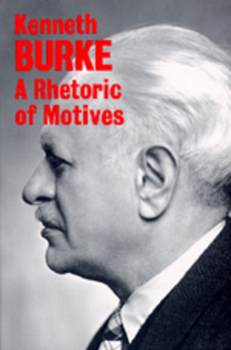A Rhetoric of Motives
Select Format
Select Condition 
Book Overview
As critic, Kenneth Burke's preoccupations were at the beginning purely esthetic and literary; but after Counter-Statement (1931), he began to discriminate a "rhetorical" or persuasive component in literature, and thereupon became a philosopher of language and human conduct.
In A Grammar of Motives (1945) and A Rhetoric of Motives (1950), Burke's conception of "symbolic action" comes into its own: all human activities-linguisitc...
Format:Paperback
Language:English
ISBN:0520015460
ISBN13:9780520015463
Release Date:October 1969
Publisher:University of California Press
Length:356 Pages
Weight:1.21 lbs.
Dimensions:0.9" x 6.0" x 8.9"
Customer Reviews
1 rating
Kenneth Burke's developing concept of Symbolic Action
Published by Thriftbooks.com User , 23 years ago
"A Rhetoric of Motives" was published in 1950, five years after "A Grammar of Motives," the first volume of a planned trilogy "On Human Relations" that was never officially completed. Having established the critical vocabulary of the dramatistic pentad in the first volume, this second work explores how all forms of human activities, whether linguistic or not, are modes of symbolizing. Specifically, Burke focuses on the relationship between persuasion and identification (hence, the focus on rhetoric rather than grammar). This is where his definition of man as the symbol-using/misusing animal comes into play. Within this context, the goal of the critic is to interpret human symbolizing in whatever arena it can be found (which necessarily means all human interactions) in order to explain human motivations.Part I "The Range of Rhetoric" sets up the key Burkeian concepts of Identification and Consubstantiality. Part II "Traditional Principles of Rhetoric" reworks those concepts into Burke's framework, using diverse texts from Dante and Machiavelli to Carlyle and Rochefoucauld to support the analysis. Part III on "Order" develops positive, dialectical and ultimate terms to establish the idea of forms that are paradigmatic of the rhetorical process as well as those that are better termed caricatures. Students of rhetoric and social theory should certainly read "A Grammar of Motives" before making their way through this volume, although a thorough appreciation of Burke would require starting with his pre-war "trilogy" of "Counter-Statement," "Permanence and Change," and "Attitudes Towards History." That middle volume is especially important in light of Burke's argument in "A Rhetoric of Motives."Burke never wrote "A Symbolic of Motives," which was to complete the trilogy. Both "Language As Symbolic Action" and "A Rhetoric of Religion" are sometimes represented as the third volume in some embryonic form, which is about as valid as such considerations can go. My argument would be that Burke's earlier works are much better sources of enlightenment and inspiration than either of those particular volumes.






